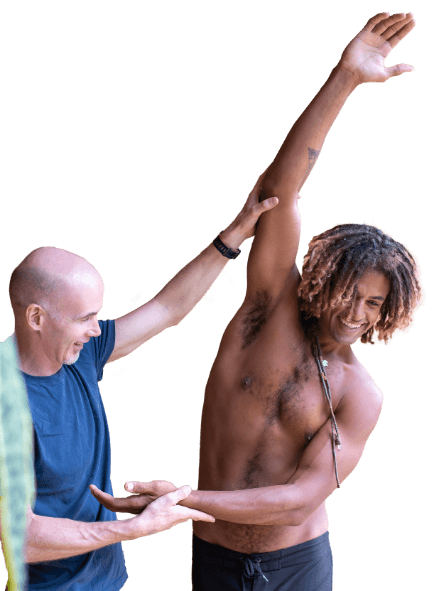
If you’re experiencing pain in your groin area, you’re not alone. Groin pain can be caused by various factors, including muscle and joint issues. In this blog, we will explore a range of exercises designed to help relieve groin pain and improve your hip and pelvic floor muscles. Before we dive in, it’s important to note that obtaining a proper diagnosis is crucial to understanding the underlying cause of your pain. If you want to use the exercises presented here and on my YouTube channel make sure your groin pain is related to muscles and joints. Remember to consult with a healthcare professional for an accurate diagnosis and individualized treatment plan.
These exercises for groin pain progress in difficulty, meaning that they can form the basis of a home-based groin rehab program for you.
However, you don’t need to do them all on day 1, or 2 for that matter. Work through the groin exercises and when you find one that causes pain or is too tough stop there and just focus on the ones before it until things start to heal in your groin.
Stretching for Groin Relief
The first exercise we will discuss is a simple stretch that targets the groin muscles, namely the adductors. Lie on your back with your feet planted on the ground and knees bent, and allow your knees to move apart naturally. If you have recently strained your groin, this stretch alone may be sufficient. To add a bit more pressure, place your hands on the inside of your knees and gently push them outward. Remember to listen to your body and stop if you experience any pain. Try doing this 10 times the first time you do it.
Hip Circumduction
Hip circumduction is another effective exercise for groin rehab. Lying on your back with both legs straight, lift your injured leg, without bending at the knee, so it points up at the sky or ceiling. From there move it in a circular motion by slowly lowering it out to the side and then returning it to lie next to your other leg.. You may notice that certain areas, such as the top portion of the movement, are more challenging or painful. Focus on working within a comfortable range of motion and gradually push your limits as your pain subsides. Aim to perform 10 repetitions of this exercise for three sets.
Isometric Strengthening
Isometric exercises involve contracting muscles without actually moving the joints. Imagine holding a weight out in front of you without lowering your arms. This is an isometric contraction for your shoulders. The muscles are working but not moving.
To strengthen the muscles on the inside of your leg, lie down and place an object (such as a rolled-up towel or a football) between your knees. Take a deep breath in, then squeeze the object between your knees for 15 to 30 seconds. Your legs shouldn’t move inward very far. Relax and repeat this exercise for three sets. You may even notice a slight “pop” or “click” in the front of your pelvis as you perform this exercise, which can help realign your pelvis and relieve pain in a strained adductor muscle.
Half Kneeling Rock Backs
For this exercise, you’ll need a mat or cushion under your knees to protect them from the hard ground. Get into a half kneeling position which means one knee is bent underneath you and the other leg is positioned straight and out to the side. Once in position, slowly move your hips backward and forward to create a stretching sensation in the groin of the straight leg. Perform 10 repetitions for three sets, and remember to do this exercise on both sides to ensure balanced muscle engagement.
The Frogger Stretch
The Frogger stretch targets both groins simultaneously. This is a classic exercise for any groin or adductor injuries. Begin in a kneeling position, spread your knees apart until you feel a slight stretch in your groin. Your feet should also be apart, ideally at the same distance as your knees. Push your hips back while maintaining a stretching sensation. To intensify the stretch, squeeze your knees together as if pushing them into the ground, or trying to activate your groin muscles to pull your knees together. Hold this position for about 5 seconds, relax, and try to deepen the stretch. If squeezing your knees together is too challenging, focus on the rocking forward and back motion instead.
Hip Mobility and Rotation
To shift the focus from the groin to overall hip mobility, try a forwards-backward dynamic lunge. Begin by placing an object underneath your knee for added comfort. Perform a kneeling lunge by moving your hips forward and backward. This will actually work both sides of your groin at the same time. Once you get used to the movement you can move your upper body into rotation, alternating between both sides. As you become more comfortable, gradually increase the range of motion and add more upper-body rotation. Aim for 10 to 15 repetitions in each position and perform five rotations in each direction.
These groin rehabilitation exercises provide a starting point for relieving groin pain and improving hip and pelvic floor function. Remember to consult with a healthcare professional to accurately diagnose the cause of your groin pain and determine the most appropriate treatment plan for your specific needs. By incorporating these exercises into your routine and gradually progressing, you can alleviate discomfort and restore optimal function in your groin area. If you found this information helpful, we appreciate your support in sharing this content with anyone you think would benefit. As always if you have any questions feel free to contact me or share your comments below. For individuals with scoliosis or back pain, consider exploring our online courses tailored to those specific conditions.

Over the last 10 years Ed has been building a YouTube library to help people manage their own pain or movement limitations and increase performance through exercise. He regularly adds videos so be sure to subscribe and visit regularly


"Oh My Gosh- I am ALREADY feeling relief after a few days! I used to wake up 2-3 times a night with shooting pain that anti inflammatories couldn't touch. Now I have been waking up just because I want to notice what it feels like to lay in bed pain free- THANK YOU!."

"When I first started with your program I was experience a lot of pain. Walking was difficult. I had to stop and catch my breath every few minutes and lean against a wall for support. Now when I walk with my husband we go for over an hour. I never had to sit down and stop...and, hardly any pain!!! 😊😊 I can’t thank you enough."
Frustrated that you aren't recovering fast enough?
Discover how to heal from illness and injury using movement, food and lifestyle.